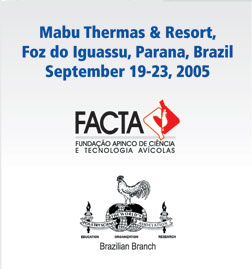MOLECULAR AND PHYLOGENETIC FEATURES OF TWO DISTINCT
dsRNA VIRUS FAMILIES INFECTING Eimeria SPP. OF DOMESTIC
FOWL
J.S. Fraga1, P.M.A. Zanotto2, S. Fernandez2, A.M.
Katsuyama1 & A. Gruber1,*
1Faculty of Veterinary Medicine and Zootechny, 2Institute
of Biomedical Sciences, University of São Paulo,
Brazil.
*argruber@usp.br
Virus-like particles
(VLPs) classified in the Totiviridae family have been
described in distinct protozoan hosts. Here we report
the complete genome sequencing of five distinct viruses
of E. brunetti, E. maxima, E. mitis and E. praecox.
A comparative analysis permitted to classify them
into two groups: Group 1, composed by Eb-RV1, Ep-RV1
and Emt-RV1, presenting a genome size of 5.3-6.2 kb;
and group 2, composed by Ep-RV2 and Em-RV1, with a
genome size of 4.2-4.3 kb. Cesium chloride gradients
of parasite lysates were performed and fractions containing
dsRNA bands were analyzed by electron microscopy (EM).
Group 1 revealed icosaedric particles similar to the
morphology of Totiviridae. Despite experimental evidences
that Group 2 dsRNA genomes are encapsidated, we were
not able to evidentiate viral particles by EM. Finally,
0.7 kb dsRNA bands were also observed in co-infection
with two distinct Group 1 Eimeria viruses. These small
elements are encapsidated and may correspond to satellite
viruses. Similarity searches of Group 1 sequences
showed significant hits to Totiviridade, whereas Group
2 sequences presented only a small similarity block
to an unclassified virus of Zygosaccharomyces bailii.
No similarity was observed between viruses of groups
1 and 2. Thus, Group 2 viruses may represent a novel
family of protozoan viruses. Phylogenetic inference
of Group 1 viruses confirmed that these viruses constitute
a monophyletic group and are more closely related
to fungal viruses than to other protozoan viruses.
These results may suggest that a progenitor of these
viruses might have been a non-infectious virus of
a cell type that predated the differentiation of protozoa
and fungi. However, the finding of two distinct and
non-related virus groups, infecting the same protozoan
host cells, may provide evidence that more than one
single progenitor may have originated the viruses
currently found in Eimeria.
Financial
support: FAPESP and CNPq
